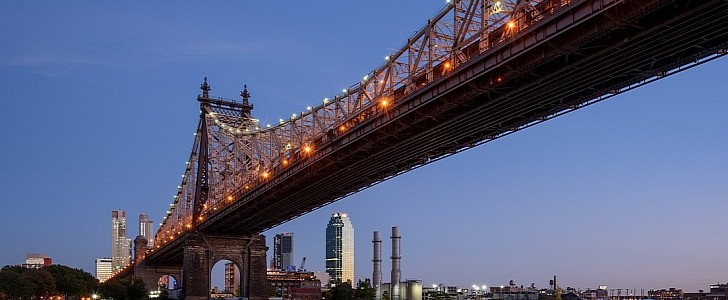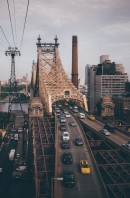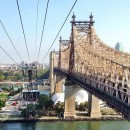Last fall, we showcased what we found to be the most anxiety-inducing bridges and tunnels in New York City and where to go instead to avoid them. Of all the bridges in that feature, perhaps none was more important than the Queensboro-59th Street Bridge.
This two-way split level double cantilever bridge has quietly been the local shortcut around outrageous Bridge tolls between Queens and the Bronx without shelling but a single penny in tolls. You may have to take a brief but intense jaunt down FDR and Harlem River Drive to do so, but local commuters swear up and down. It's totally worth it. With some of the stiffest toll late-fees anywhere in the world, you'd be forgiven for being cautious. Sometimes, EZ Pass just isn't enough.
But the 110-plus-year-old Queensboro hasn't had a toll since the cost to drive across it was ten cents back in 1909. But this toll was quickly abolished in 1911 by the Mayor of New York City, William J. Gaynor. The devout Irish-Catholic son of Ellis Island Immigrants was openly against what he saw as an exploitative public bridge-toll policy.
Telling the press of the day," For my part, I see no more reason for tollgates on the bridges than for tollgates on Fifth Avenue or Broadway," elaborating by calling them "inconvenient and irksome." Why this man didn't run for president, we have no idea. He would have won in a landslide, we tell you! No wonder he was actually born in Upstate New York. Yes, we went there.
Even as other, newer bridges like the Whitestone and Throgs Neck Bridge happily plundered City drivers of their hard-earned money, Gaynor's policy towards the original big four Manhattan bridges with tolls sticks even today. The 3,724 foot, six-inch (1,135.2 m) bridge was designed by a Czech immigrant named Gustav Lindenthal, also famous for the Hell's Kitchen bridge used to this day in service with Amtrak. Its chief architect was another Upstate New York native, Leffert L. Buck of the small village of Canton, just south of the Canadian Border.
Buck is credited with the architecture for the Williamsburgh Bridge, another of the four OG Manhattan car bridges. The span between Manhattan and Roosevelt Island was the verified longest cantilever in North America. That was until the Quebec Bridge in Canada surpassed it in 1917. Even so, the bridge was a marvel of engineering. Serving as a major hub for Queens, Manhattan, and the tiny Roosevelt Island in between the two Boroughs over the East River.
Everything from automobile traffic to bicycle racing and even stretch of the New York City Marathon calls the Queensboro bridge home. That's not even counting the iconic cable cars that run parallel to the bridge between Manhattan and Roosevelt Island. Those could be a whole feature by themselves.
The bridge is also very prominent in print and screen media depicting New York City. In the classic American novel, The Great Gatsby by F. Scott Fitzgerald, the main character Nick Carraway describes the Queensboro Bridge more eloquently than we ever could. The City seen from the Queensboro Bridge is always the City seen for the first time, in its first wild promise of all the mystery and the beauty in the world". How's that for a hype-up? Not bad, if you ask us.
There are longer bridges and older bridges. But anyone who doesn't understand the appeal behind the one-of-a-kind aesthetic of this bridge must be confused why it doesn't have built-in WiFi-6 and 5G connectivity. To those people, we say this. Get outside more, dude. There's more to life than Tik Tok.
But the 110-plus-year-old Queensboro hasn't had a toll since the cost to drive across it was ten cents back in 1909. But this toll was quickly abolished in 1911 by the Mayor of New York City, William J. Gaynor. The devout Irish-Catholic son of Ellis Island Immigrants was openly against what he saw as an exploitative public bridge-toll policy.
Telling the press of the day," For my part, I see no more reason for tollgates on the bridges than for tollgates on Fifth Avenue or Broadway," elaborating by calling them "inconvenient and irksome." Why this man didn't run for president, we have no idea. He would have won in a landslide, we tell you! No wonder he was actually born in Upstate New York. Yes, we went there.
Even as other, newer bridges like the Whitestone and Throgs Neck Bridge happily plundered City drivers of their hard-earned money, Gaynor's policy towards the original big four Manhattan bridges with tolls sticks even today. The 3,724 foot, six-inch (1,135.2 m) bridge was designed by a Czech immigrant named Gustav Lindenthal, also famous for the Hell's Kitchen bridge used to this day in service with Amtrak. Its chief architect was another Upstate New York native, Leffert L. Buck of the small village of Canton, just south of the Canadian Border.
Everything from automobile traffic to bicycle racing and even stretch of the New York City Marathon calls the Queensboro bridge home. That's not even counting the iconic cable cars that run parallel to the bridge between Manhattan and Roosevelt Island. Those could be a whole feature by themselves.
The bridge is also very prominent in print and screen media depicting New York City. In the classic American novel, The Great Gatsby by F. Scott Fitzgerald, the main character Nick Carraway describes the Queensboro Bridge more eloquently than we ever could. The City seen from the Queensboro Bridge is always the City seen for the first time, in its first wild promise of all the mystery and the beauty in the world". How's that for a hype-up? Not bad, if you ask us.
There are longer bridges and older bridges. But anyone who doesn't understand the appeal behind the one-of-a-kind aesthetic of this bridge must be confused why it doesn't have built-in WiFi-6 and 5G connectivity. To those people, we say this. Get outside more, dude. There's more to life than Tik Tok.






